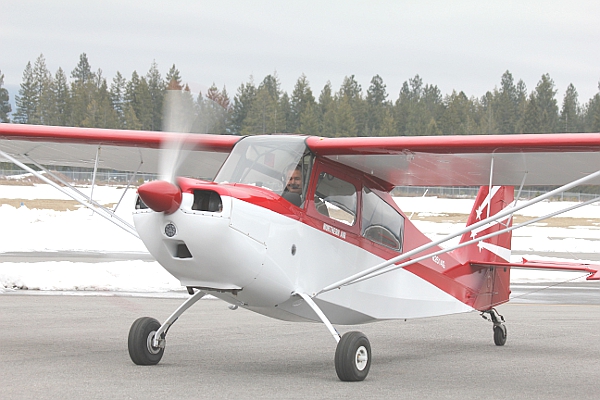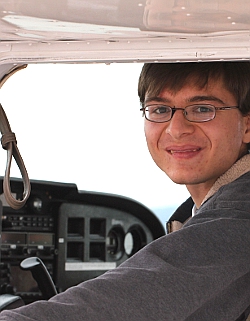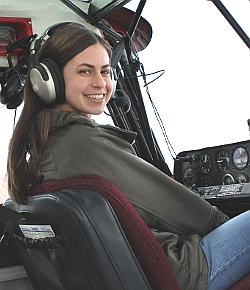Taildragger takes to the sky
|
|
February 25, 2013 |
 |
|
Dave Parker
at the controls of the newest Northern
Air acquisition, a 1964 Citabria, a
taildragger purchased as a pile of parts
more than two years ago, now in the air
once again. |
| Northern Air
Photo |
|
 |
By Ashley Glaza
Northern Air |
Spring was in the air early this February. The
snow is almost gone from the valley and the
longer days and warm sunshine brought out all
the eager pilots who were blocked from their
planes by a two foot snow bank in front of their
hangar door all winter.
One of the aircraft soaring off the runway and
into the sunshine this month had been grounded a
little longer than most, and it was beautiful to
see her fly.
Northern Air has had a busy winter, with the new
group of student pilots enrolled in ground
school as well as those who are finishing up
from last year.
On February 11, Nathan Negoi took his first solo
flight. Nathan received an EAA Scholarship in
2012, took the ground school and has been
volunteering at the airport at every chance to
build as much airplane experience as he can.
 |
|
Nathan Negoi |
Northern Air is proud to announce the newest
addition to its fleet, a 1964 American Champion
Citabria (Citabria is Airbatic spelled
backwards). Dave Parker, owner and president of
Northern Air, purchased the plane as a
disassembled pile of parts, and spent the last
two and a half years rebuilding, repainting, and
updating components to like-new condition with
the help of the Northern Air mechanics Kevin
Lamp and Daryl Johnson, and his children, Jade
and John.
Dave named the plane “Jade” after his daughter,
who is currently enrolled in ground school.
On February 10, Dave took the plane for its
“maiden” flight, and it has been busy with
pilots eager to earn their tailwheel training
ever since.
The more commonly known tricycle gear aircraft
have the two main wheels under the wings and a
third under the nose.
A tailwheel aircraft has the third wheel under
the tail, which is more forgiving when landing
on soft or rough surfaces such as turf or
gravel, making it ideal for backcountry flying
enthusiasts, but is somewhat more of a challenge
to land and take off.
 |
|
Jade Parker
in the cockpit of the plane that now
bears her name. |
Because of this challenge, the Federal Aviation
Administration requires a pilot to receive
training from a certified instructor in a
tailwheel aircraft (also known as a taildragger)
and an endorsement in their logbook before they
can legally fly one.
When a taildragger touches down, it is
imperative to keep the airplane straight down
the runway, because any small deviation of the
tail from the centerline, without immediate
correction, can accelerate into a complete
“ground loop” where the tail of the airplane
swings around to the front, and at high speeds
this can result in significant damage to the
airplane.
If the wind is not blowing straight down the
runway, and a crosswind condition exists, the
pilot must be extremely competent and diligent
on landing and takeoff.
Airplanes were originally designed with the
tailwheel configuration back in the days when
there were no designated paved runways, and
pilots took off from a grass or dirt field
straight into the wind depending on which
direction it was blowing.
World War II led to a need for the heavier
aircraft that carried bombs and extra fuel which
required firm, smooth, paved runways.
The tricycle wheel configuration was development
as a result, because landings and takeoffs in
taildraggers became more difficult when the
winds were not blowing straight down the runway.
Another reason for the development of the
tricycle gear was the introduction of jet
engines.
When a tailwheel aircraft is sitting on the
ground, it is in a nose-high position, and
jet-blast from the engines on these planes
tended to burn holes in the runways. The
tricycle gear style lifted the tail up so that
the jets would blast straight out the back
instead of into the ground.
Today taildraggers are less common, but seen by
many as an extra challenge to fly after
mastering the tricycle gear.
It is also the common configuration for
backcountry pilots because it is more forgiving
in rough terrain, and many “warbirds” and other
historical aircraft retained the tailwheel
configuration.
Anyone interested in learning more about
tailwheel aircraft can reference several books,
including "Conventional Gear – Flying a
Taildragger," by David Robson, or "The Complete
Taildragger Pilot," by Harvey S. Plourde, or
stop by Northern Air to see the new Citabria.
Northern Air is now offering tailwheel training
in the Citabria, and intends to add aerobatic
training in the future. For more information
call (208) 267 4359. |
|
Questions or comments about this
letter?
Click here to e-mail! |
|
|
|
|

